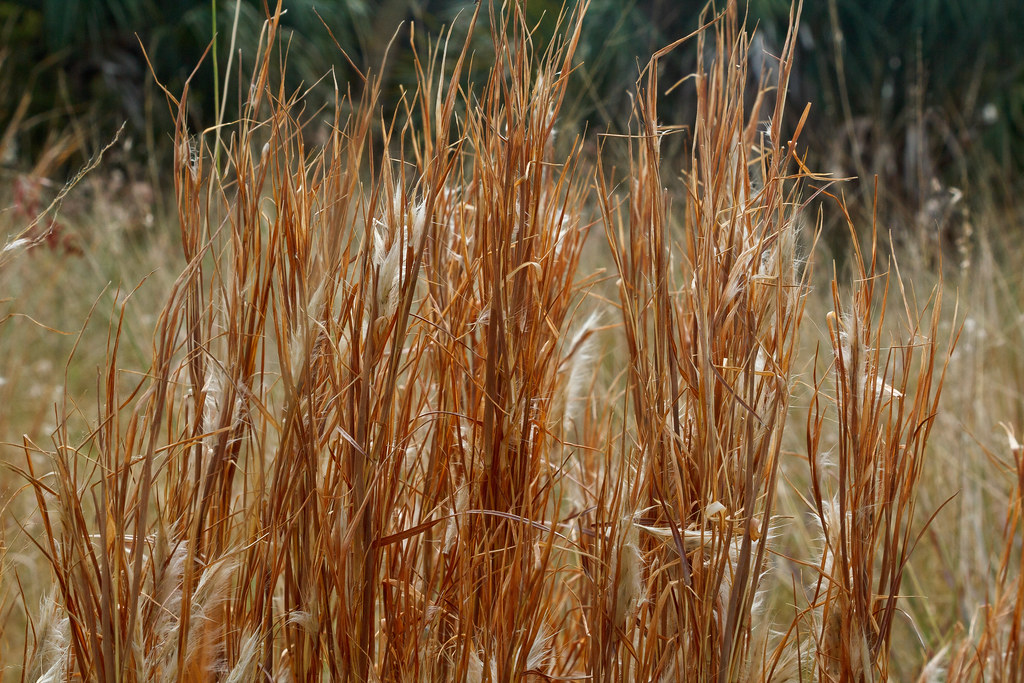Broomsedge Bluestem is an Opportunistic-Indicator Plant
 The grass that gives a lot of eastern Oklahoma pastures the bronze or copper colored
appearance during the fall and winter is broomsedge bluestem, also known as “sage
grass.” Broomsedge is a native grass that grows well on sites that have low fertility
or pH. It is allopathic, meaning it produces a toxin that inhibits the growth of other
plants. Most animals will avoid grazing this plant except in the early spring and
when other forage is not available. This explains why Broomsedge can become the dominant
species in a pasture. Broomsedge is an opportunistic plant that takes advantage of
poor fertility management and overgrazing. It also is a good indicator of needed management
changes to the grazing system. A common question at most Extension offices is how
to get rid of broomsedge bluestem.
The grass that gives a lot of eastern Oklahoma pastures the bronze or copper colored
appearance during the fall and winter is broomsedge bluestem, also known as “sage
grass.” Broomsedge is a native grass that grows well on sites that have low fertility
or pH. It is allopathic, meaning it produces a toxin that inhibits the growth of other
plants. Most animals will avoid grazing this plant except in the early spring and
when other forage is not available. This explains why Broomsedge can become the dominant
species in a pasture. Broomsedge is an opportunistic plant that takes advantage of
poor fertility management and overgrazing. It also is a good indicator of needed management
changes to the grazing system. A common question at most Extension offices is how
to get rid of broomsedge bluestem.
Broomsedge is relatively short lived for a perennial grass. In fact, 50% of existing plants will only survive about three years, 90% are gone by year six and all plants will die by the age of seven. Anything that makes the desirable grasses more competitive and reduces the survival of new broomsedge seedlings will hasten the reduction of the broomsedge population. A 1936 study at a TN Ag Experiment Station found that the addition of needed N, P and K coupled with regular defoliation through intensive early grazing created competition from desirable grasses and reduced a 90% ground cover broomsedge stand to less than 5% cover within four years. This has been duplicated many times since then. Applications of lime in low pH soils have also shown reductions in broomsedge due to ensuing competition from desirable species.
Controlling broomsedge in introduced pastures, such as bermudagrass or fescue, is fairly easy but does require a little patience. Soil testing is the key and will reveal any deficiencies in P,K or a low pH. Correcting these deficiencies will go a long way towards rescuing the forage stand from broomsedge. Again, intensive grazing early in the year when broomsedge is moderately palatable to the animals will further stress the broomsedge plants into submission. Rotational stocking can also be used to force animals to graze broomsedge in the spring and early summer.
Controlling broomsedge in native range sites is more difficult than in introduced grasses. In range sites we rely on cultural practices such as fire and grazing management to hopefully reduce or at least slow the spread of broomsedge bluestem. Native grasses do not respond efficiently to fertilizer like the introduced grasses. Therefore, the use of an intensive early stocking program to graze broomsedge, followed by resting the stand through the remainder of summer is beneficial. Rest allows our desirable native grasses an opportunity to restore lost energy and produce a healthier, more competitive stand. Native hay meadows should only be baled once per year to increase competition with broomsedge. Oklahoma research has shown a fall prescribed fire within 1-2 weeks of the killing frost is the best way to reduce broomsedge stands in native sites. This stresses the broomsedge plant during preparation for winter and burns seeds still on the plant. Don’t expect this method to work as fast as in introduced forages.
Again, remember that broomsedge is an indicator of improper management. Promoting our desirable forage species through fertility, lime, harvest strategy or fire will reduce this short-lived grassy nuisance quickly.
